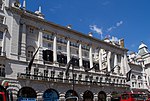St. James's Hall was a concert hall in London that opened on 25 March 1858, designed by architect and artist Owen Jones, who had decorated the interior of the Crystal Palace. It was situated between the Quadrant in Regent Street and Piccadilly, and Vine Street and George Court. There was a frontage on Regent Street, and another in Piccadilly. Taking the orchestra into account, the main hall had seating for slightly over 2,000 persons. It had a grand hall 140 feet (43 m) long and 60 feet (18 m) broad, the seating was distributed between ground floor, balcony, gallery and platform and it had excellent acoustics. On the ground floor were two smaller halls, one 60 feet (18 m) square; the other 60 feet (18 m) by 55 feet (17 m). The Hall was decorated in the 'Florentine' style, with features imitating the great Moorish Palace of the Alhambra. The Piccadilly facade was given a Gothic design, and the complex of two restaurants and three halls was hidden behind Nash's Quadrant. Sir George Henschel recalled its 'dear old, uncomfortable, long, narrow, green-upholstered benches (pale-green horse-hair) with the numbers of the seats tied over the straight backs with bright pink tape, like office files.'The Hall was built jointly by two music publishing firms, Chappell & Co. and Cramer & Co., in the hope of attracting the growing audiences for fine musical performances that attended the Crystal Palace and the halls being built in the provinces. It stood empty for nearly a year after its opening. For almost half a century thereafter, the Hall was London's principal concert hall, to be succeeded by Queen's Hall in the 1900s and later by Wigmore Hall, the Royal Albert Hall and Royal Festival Hall. It became famous for its 'Monday Pops' concerts and Ballad Concerts, as the home of the Philharmonic Society and the Christy Minstrels and for the many famous conductors and performers who gave important performances there.








